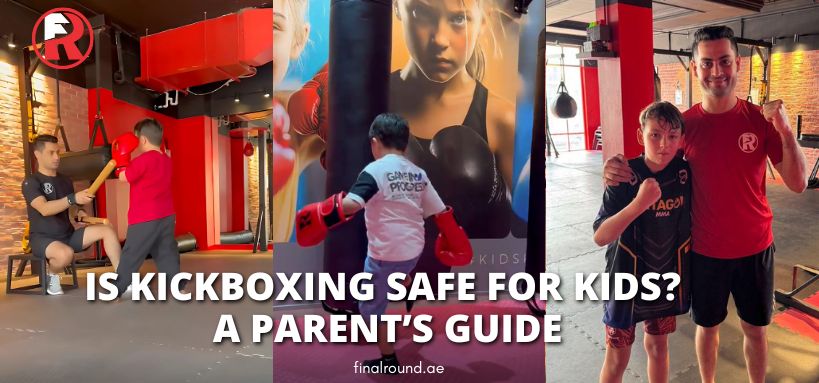Kickboxing is becoming more popular among children as both a sport and a fitness activity. Parents see it as a way to build strength, discipline, and self-confidence. But there’s still one big question: is kickboxing safe for kids?
The answer depends on how it’s taught, the safety measures in place, and the type of training your child receives. This guide will walk you through the benefits, risks, and tips for ensuring your child can enjoy kickboxing in the safest way possible.
Understanding the Question – Is Kickboxing Safe for Kids?
When parents ask is kickboxing safe for kids, they’re really asking about the environment, supervision, and training methods. Like any sport, kickboxing has risks, but with proper instruction and protective gear, it can be a safe and highly rewarding activity.
In most children’s kickboxing programs:
- Contact is limited
- Techniques are taught in stages
- Fun and learning come before competition
This means kids can enjoy the benefits of martial arts without being exposed to unnecessary dangers.
Benefits of Kickboxing for Kids
1. Physical Fitness
Kickboxing is a full-body workout that improves:
- Strength – punching and kicking build muscle
- Cardio health – fast-paced drills keep the heart healthy
- Flexibility – stretching before and after training increases range of motion
- Balance & coordination – footwork drills improve control
These benefits don’t just help in the gym — they also support overall growth and everyday movement.
2. Mental Strength
Kickboxing is as much mental as it is physical. Children develop:
- Focus – they learn to pay attention to instructions
- Discipline – showing up regularly builds consistency
- Confidence – mastering techniques boosts self-esteem
- Stress relief – hitting pads in a safe environment helps release tension
Many parents notice improvements in their child’s behavior, concentration at school, and emotional control.
3. Social Skills
Kickboxing classes encourage teamwork. Kids work with partners, respect their peers, and learn sportsmanship. They make friends while sharing a common goal — getting better together.
Risks in Kids’ Kickboxing and How to Reduce Them
While kickboxing is generally safe when done right, there are still risks to consider. These are similar to other sports like soccer or gymnastics.
Possible Risks
- Minor bruises
- Sprained ankles or wrists
- Muscle strains
- In rare cases, head injuries (mostly in full-contact situations)
How to Minimize Risks
- Choose the right school – Make sure it offers kids-only classes with trained instructors.
- Use protective gear – Gloves, shin guards, mouthguards, and sometimes headgear.
- Follow age-appropriate training – Younger children should focus on technique, not hard sparring.
- Supervised environment – Instructors must correct bad form immediately.
When these steps are followed, is kickboxing safe for kids becomes a much easier question to answer with “yes.”
Age-Appropriate Kickboxing Training
Ages 5–7
- Focus on fun drills and footwork games
- No sparring
- Basic punches and kicks on pads
Ages 8–12
- More structured combinations
- Light, controlled sparring (optional)
- Introduction to defense techniques
Ages 13+
- Advanced drills
- Controlled sparring with full gear
- More intense conditioning
This gradual approach builds skills while keeping safety the top priority.
Signs of a Safe Kickboxing Class for Kids
Here’s what to look for when evaluating a program:
- Certified instructors with experience teaching children
- Small class sizes so each child gets attention
- Warm-up and cool-down routines to prevent injuries
- Clear rules on safety and respect
- Parent communication about progress and any concerns
If a gym allows young kids to spar hard right away, that’s a red flag.
The Role of Protective Gear
Gear is essential for reducing injury risks:
- Gloves – protect hands and wrists
- Shin guards – cushion kicks
- Mouthguards – protect teeth
- Headgear – optional for kids’ classes but used in light sparring
Good gyms insist on proper gear for every class.
Kickboxing vs. Other Kids’ Sports Safety
Parents sometimes wonder if kickboxing is more dangerous than other sports. In reality:
- Soccer and basketball have high rates of ankle and knee injuries
- Gymnastics can lead to falls and joint injuries
- Kickboxing, with proper control, has fewer high-impact falls and more focus on form
So, is kickboxing safe for kids compared to other sports? When supervised well, yes — and it’s often safer than people expect.
Mental Health Benefits Parents Don’t Expect
Kickboxing doesn’t just build muscle — it helps kids handle life better. Children who train often:
- Show more patience at home
- Manage school stress more easily
- Stand up for themselves without aggression
- Develop a “never give up” attitude
This is why many parents see kickboxing as an investment in their child’s character.
Choosing the Right Kickboxing Program for Your Child
Before signing up:
- Visit the gym – watch a kids’ class in action.
- Talk to the instructors – ask about safety rules and experience.
- Ask about injury rates – good gyms are open about this.
- Check the vibe – are kids smiling, focused, and respectful?
Common Myths About Kids and Kickboxing
Myth 1: It will make my child aggressive.
Reality: Kids are taught control and respect — not uncontrolled fighting.
Myth 2: It’s too dangerous for children.
Reality: With gear and proper training, it’s no riskier than other youth sports.
Myth 3: Only boys should do kickboxing.
Reality: Girls benefit just as much — sometimes more — from the confidence it builds.
Parent Tips for Supporting Your Child in Kickboxing
- Encourage consistent attendance
- Make sure gear fits properly
- Ask them to share what they learned after class
- Celebrate small achievements, not just big wins
- Stay in touch with their coach
Your involvement helps your child stay motivated and safe.
Final Thought – Is Kickboxing Safe for Kids?
When taught by qualified instructors in a well-structured program with proper protective gear, is kickboxing safe for kids? The answer is a confident yes.
Your child can enjoy:
- Improved fitness
- Better discipline and focus
- Friendships and teamwork
- A safe space to release energy
Like any sport, it’s not risk-free — but with the right approach, the benefits far outweigh the risks.
FAQs
1. What age can my child start kickboxing?
Most programs start around ages 5–6 with light training.
2. How often should kids train?
Two to three times a week is a good balance.
3. Will my child get hit in the head?
In well-run kids’ programs, head contact is minimal or not allowed.
4. Does kickboxing help with school performance?
Yes, the discipline and focus often carry over to schoolwork.
5. Is it expensive?
Costs vary, but many gyms offer affordable kids’ programs.





